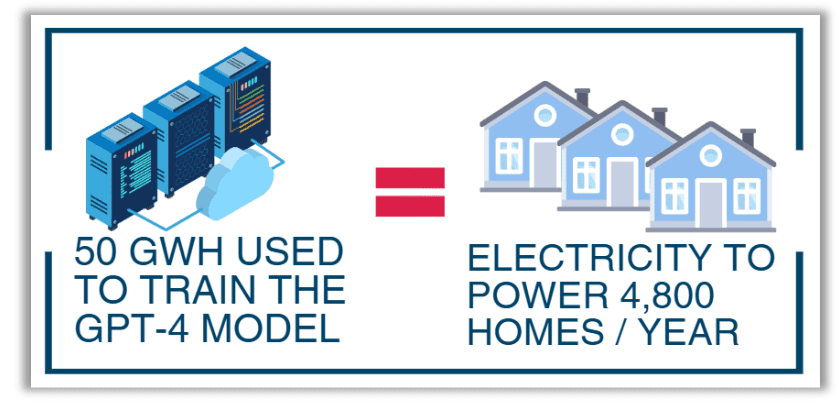House Report Summarizes AI Effect on Vital Industries
Randy Sukow
|

From the task force report, a graphic representation of energy needs for GPT-4, OpenAI’s latest AI platform. “It can take in and generate up to 25,000 words of text, around eight times more than ChatGPT,” according to an OpenAI promotional video.
In the early days of the new Congressional session, the House of Representatives has outlined the items of general agreement surrounding artificial intelligence (AI). The recently released Bipartisan Task Force Report finds that the United States is the “undisputed” leader in AI research, investment and adoption. The task force said the report’s purpose is to help Congress set priorities and develop legislative strategy to maintain that advantage.
“The report details a roadmap for Congress to follow to both safeguard consumers and foster continued U.S. investment and innovation in AI,” said Task Force Chairman Jay Obernolte (R-CA) in a press release. “I am confident that this report will be an essential tool for crafting AI policy that protects Americans, spurs innovation, and secures American leadership in this revolutionary technology.”
The group organized the report into chapters that summarize AI’s effect on various industries and governmental functions. It includes policy recommendations at the end of each chapter. In total the report includes 66 findings and 89 recommendations.
For example, one chapter centers on energy usage and data centers, a topic of increased interest to the National Telecommunications and Information Administration (NTIA) in recent months. While demand for AI applications increases demand for electric power from AI data centers (see graphic above), the report also finds that “industry innovation in AI technology produces new approaches to reducing power consumption while preserving performance.”
The report recommends that Congress “ensure that AI and the energy grid are a part of broader discussions about grid modernization and security.” It also recommends using AI to deploy more energy-efficient infrastructure. At the same time, it urges that technology companies bear most of the cost of development and transition to new infrastructure rather than residential rate payers.
“Artificial intelligence has emerged as a powerful tool capable of revolutionizing agriculture,” the report says. “AI can improve the processes that form the modern agricultural sector, from crop management to supply chain logistics, leading to greater aggregate efficiency and productivity.” AI has natural parallels to ongoing FCC efforts to promote precision agriculture.
The report cites a Government Accountability Office finding a year ago that only 27 percent of farms and ranches in the United States take advantage of precision agriculture in spite of the technologies being available since the 1990s. “Since many advanced technologies, including AI, require connections to servers or cloud providers, widespread adoption of state-of-the-art precision agriculture will be hampered until network access across agricultural communities is bolstered,” according to the report.
Other barriers, according to the report, are the high up-front costs for precision ag equipment and system complexity. The report recommends evaluating existing U.S. Department of Agriculture programs and adjusting them to better support AI and modern technologies.
At the same time, the task force suggested that AI could improve agricultural land management for more productive crop yields as well as better “forest health.” Other chapters cover AI’s influence on education and workforce development, healthcare, small business with specific references to rural America.


